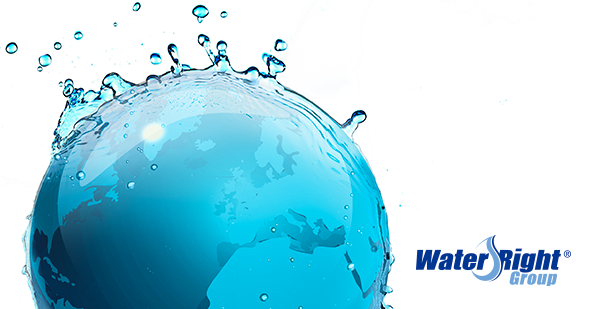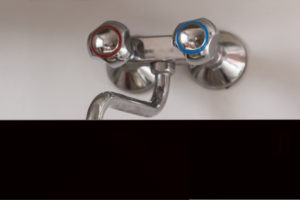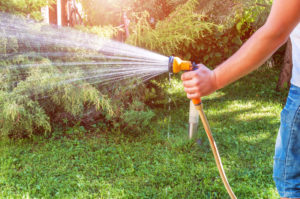
Celebrate Earth Day with These 8 Effective Water Saving Tips
From washing your hair to watering your flower garden, it can be difficult to keep track of how much water is actually needed for daily routines. While letting the water run for an extra minutes you brush your teeth may not seem like a big deal, you may be surprised to find everyday tasks like this contribute to more than 1 trillion gallons of water wasted every year.
The good news is curbing your water usage is easier than you think. Here are 8 simple ways you can cut back on water waste, promote sustainability, and save a little money along the way.
1. Look for Leaky Faucets and Pipes
If you’re noticing standing water under your kitchen sink or a steady drip when the faucet is turned off, chances are you’re dealing with a leaky valve or pipe in your home. Though it may seem like more of a nuisance than a serious problem, minor leaks can add up fast. A small drip from your faucet can waste as much as 20 gallons of water per day. A faucet leaking just 10 drips per minute wastes more than 500 gallons of water per year, which can cost you an additional $10 over a 12-month period. If more than one faucet is leaking at a time, the cost can escalate quickly.
 Leaks can spring from several areas on a faucet. The most common is the spout. A leak here will result in running and dripping water, even when the handle is completely turned off. If the leak has grown progressively worse over time, chances are your leak is coming from the spout.
Leaks can spring from several areas on a faucet. The most common is the spout. A leak here will result in running and dripping water, even when the handle is completely turned off. If the leak has grown progressively worse over time, chances are your leak is coming from the spout.
The other two areas where leaks are common are in the faucet base and under the sink. Leaks at the base and under the sink can be difficult to detect since they’re generally only identifiable when the water is running.
The good news is that repairing a leaky faucet is simple and inexpensive, and can help save you water and money on your monthly water bill. Click here to learn how to fix a leaking compression faucet.
2. Check Your Toilets for Leaks
Twelve percent of all water use in the home comes from water leaks, with toilet leaks being one of the most common sources. In fact, a continuously running toilet can waste between 1,000 and 4,000 gallons of water per day and can potentially increase your bill by hundreds of dollars each year if unrepaired.
There are simple DIY tests you can perform if you suspect your toilet is leaking or running consistently. One way to pinpoint a leak is to squeeze a couple drops of food coloring in your toilet tank. If you notice the color beginning to appear in the bowl in the first 30 minutes without flushing, you are dealing with a leak.
Much like repairing a faucet leak, fixing a leaking toilet is an inexpensive and easy way to cut back on water waste and save money on your water bill.
3. Take Shorter Showers
One way to cut down on water use is to turn off the shower after lathering up, and only turn it back on when it’s time to rinse. The average person spends around eight minutes in the shower, which equates to approximately 18 gallons of water used every time you rinse off.
With more than 300 million people in the United States, scaling back one minute of shower time can save approximately 165 billion gallons of water each year, which translates to significant savings in both water heating energy and money in the long run.
In addition to cutting down on your shower time, installing an energy efficient showerhead may help to reduce water waste without compromising your water pressure or showering routine.
Installing a faucet aerator is another great way to conserve water and energy consumption since it limits the flow of water through the faucet. Faucet aerators are particularly beneficial when using hot water, as limited water flow means less heat energy is used.
4. Don’t Use Your Toilet as a Trash Can
You may be tempted to throw your facial tissue in the toilet instead of carrying it to the trash can, but think again. The amount of water needed to flush varies based on the age of your toilet, with older toilets using 3-5 gallons of water and newer toilets using 1-2 gallons. However, over time, unnecessary flushes can add up.
The average household uses more water for toilet flushing than any other activity in the home, accounting for roughly 31% of a home’s water consumption. So, be smart about how often you flush.
5. Turn Off the Tap When You Brush Your Teeth
Depending on your commitment to dental health, most individuals spend 2-4 minutes in front of the sink brushing their teeth each day. Letting the faucet run as your clean your pearly whites may not seem like a big deal, and chances are you don’t even realize the water is on during this time, but just one minute of brushing with the faucet turned on uses more than a gallon of water.
In fact, over the course of the year, this equals out to more than 1400 gallons of water, enough to fill your bathtub roughly 30 times. Being mindful of how long and how often you run the water is a simple task that can have a substantial impact on your energy bill.
6. Only Wash Full Loads in the Dishwasher and Washing Machine
When it comes to washing linens and clothes, make sure that you are running full loads of laundry only. With the average top loading washing machine using 40 gallons of water per cycle, running your washing machine for half loads or single items contributes to hundreds of gallons of water and money wasted.
One way to lower your water bill when doing laundry is to skip the extra rinse cycle. Most washing machines have an option for an extra rinse, but using the right amount of soap can give you the same results without using excess water. If your home has hard water, your appliances may be working harder than they need to. Installing a water softener can also help give you cleaner clothes with less water used.
Cutting down on the number of laundry loads each week can also help you save on water and money. Reusing your bath and dish towels for multiple washes and waiting until your laundry basket is full to run a load are great ways to minimize water waste. In addition, cutting down on the amount of loads washed each week may free up some time normally spent on household chores.
7. Reuse Water When Possible
Just like reusing dish and bath towels helps lower your energy use, collecting and using water from rainfalls can translate to big savings on your energy and utility bills each month. In fact, according to the U.S. Environmental Protection Agency (EPA), just one rain barrel can save homeowners as much as 1,300 gallons of water in the summer months. In particularly rainy climates, you may even collect enough water to feed your indoor and outdoor plants throughout the spring and summer.
8. Water Your Lawn Sparingly
When it comes to watering your lawn, many homeowners believe more is better. But, you may be surprised to learn your lawn doesn’t need to be watered as often as you think. In fact, nearly 50% of water used outdoors is wasted due to evaporation, wind, or runoff caused by inefficient irrigation systems. Watering too often for too long can lead to a higher monthly utility bill and is a welcome mat for diseases in plants, insect infestations, and thatch problems.
Even a brief sprinkling every day is ineffective because water evaporates quickly and can lead to shallow root systems in the ground. Instead, you should water your lawn deeply once a week for roughly an hour or so, just long enough for it to soak down into the roots where moisture is needed most.
One simple way to tell when your lawn has been watered well enough is to place an empty tuna can on your lawn prior to turning on your hose or sprinkler. When the can is full, you’ve given your lawn about an inch of water, which is the amount needed to reach the roots.
Another trick to cut down on water usage is to water your lawn at the time of day when the temperature is lowest – typically in the early morning or late evening. This reduces the amount of water lost to evaporation.
Save Money, Energy, & Water with Water-Right®
From storing rainwater to cutting down on laundry loads, you’ve gone to great lengths to conserve water. But did you know that reducing your energy consumption and saving money begins with having the right water?
Installing a water softener can help your home save water, energy, and money in the long run. That’s because washing with soft water can cut down on as much as 50% of the detergent needed to run your dishwasher and washing machine. Soft water also increases the lifespan of your appliances, which helps to reduce the amount of water needed to run effectively and lessen the amount of money spent on repairs.
If you love the water saving abilities of a water softener, but prefer a crisper taste, bundling your softener with an RO (reverse osmosis) system may be right for your home. RO systems remove fluoride, chlorine, and other impurities from your drinking water to provide safe, great-tasting water in your home whenever you want it. Contact us to learn how you can get the water you deserve each time you turn on the tap.
All Water-Right® dealers are equipped to help you with your needs.
Click the links above to visit the websites of our trusted brands. You can use the ‘Find a Dealer’ tool to locate a professional near you and have an expert come to your home to evaluate your situation.
For those who have serious concerns about water quality or potential contamination, you can have your water tested at our Clean Water Testing center to get the answers you need.

